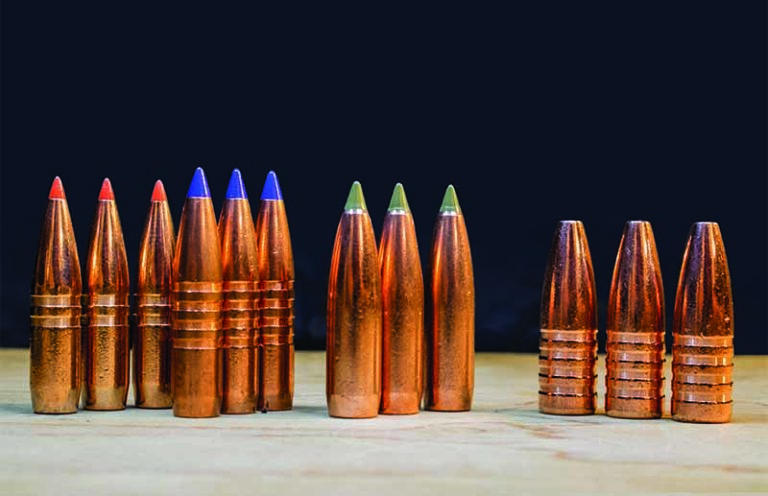
Monometal bullets are here to stay, because the technology has developed to be both reliably accurate and lethal.
“Whaddya mean there’s no lead in the bullet? That’s impossible!”
So proclaimed my father—Ol’ Grumpy Pants—when I first tried to explain the concept of the Barnes X bullet to him over two decades ago.
“Look, bullets are made either of all lead or a lead core with a copper jacket,” OGP instructed.
“No, Pop, these Barnes bullets are just copper—no lead core; they simply can’t separate, because it’s all one homogeneous piece of metal,” I retorted.
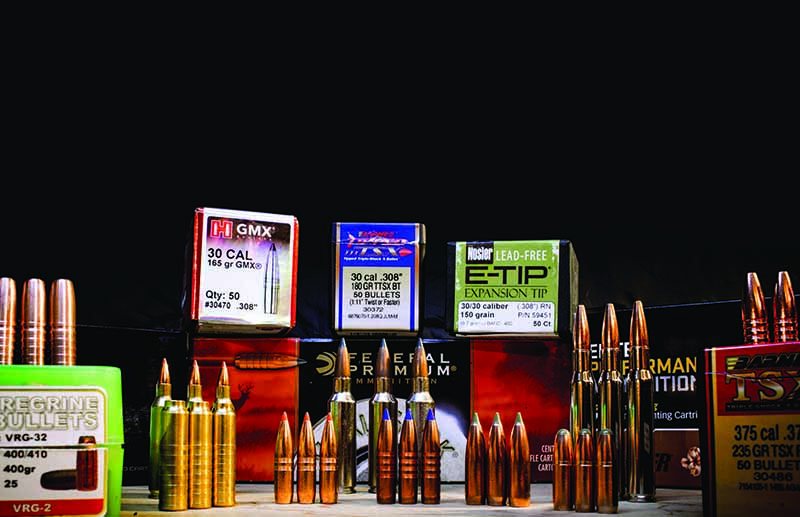
In his usual manner, he just looked at me and shook his head. In spite of his skepticism, I ordered the newfangled bullets anyway, and he thoroughly enjoyed watching me get more and more frustrated when they wouldn’t shoot from any of my rifles. Zero, zip, nada.
I ended up with a serious amount of copper in the barrels of my .308 Winchester, .300 Winchester Magnum, and .375 H&H … and also on a set of targets (which I was embarrassed about).
I abandoned the idea and went running back to my tried-and-true lead-core bullets for a couple of seasons—until I saw the Barnes XLC bullets, coated in some funky, blue powder designed to reduce both friction and copper fouling. I eagerly placed my order for these new monometal hollow-points and went to the reloading bench—at that time, located in the surveying office my father and I share.
“Now, what?!” he inquired as he looked at the quirky, blue bullets. As I began to explain, he stopped me mid-sentence. “Never mind, I don’t want to know.”
Long story short, the XLCs didn’t shoot for me either, and I gave up on monometal bullets entirely for the better part of a decade … until I saw Barnes rework the bullet into the TSX (Triple Shock X), we all know and love. “The third time’s the charm,” as the saying goes, and it proved to be true in this instance.
The Barnes TSX had three grooves cut into the shank of the bullet in order to “reduce fouling and enhance accuracy.”
So, it wasn’t me after all! It seemed as if there were two camps: those hunters whose rifles absolutely loved the original Barnes X (not me) and those who couldn’t get them to shoot at all (definitely me). But, with the release of the TSX, I found a bullet my barrels liked; the deer didn’t like them so much though.
The accuracy was certainly there, and the terminal ballistics of these bullets were a force to be reckoned with. The hollow-point opened into four petals like a copper flower (the form of which was the inspiration for the “X’” designation), and these bullets offered both high weight retention and deep penetration. Many hunters actually dropped down in bullet weight, because they were getting the performance of a heavier cup-and-core bullet with a lighter monometal bullet. (We’ll get into that a bit more in just a minute.)
Properties Of A Monometal Bullet
Our most common hunting bullets use a lead core surrounded by a jacket, or cup, of copper. That jacket is soft enough to engage the barrel’s rifling to impart a proper spin on the bullet. Nevertheless, it’s much harder than lead, so the structural integrity is preserved, and the rapid and violent expansion of a lead bullet is mitigated … to a point.
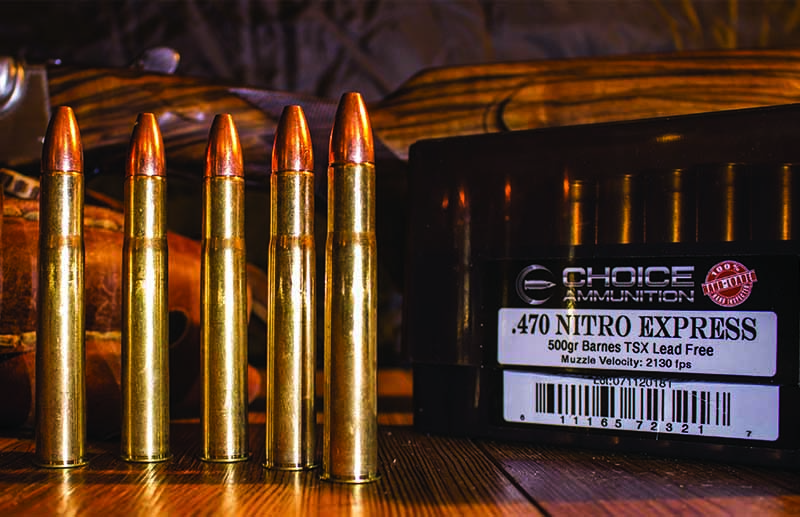
As cartridge and powder technology advanced throughout the 20th century, hunters found the limits of the cup-and-core design.
John Nosler saw a bull moose soak up cup-and-core bullets from his .300 H&H. This led to the design of his innovative Nosler Partition bullet—a staple in the industry to this day. But, according to Randy Brooks, who had purchased Fred Barnes’ bullet company, he (Brooks) was glassing for brown bear in Alaska when the idea to do away altogether with the lead core came to him. Brooks admitted to me that the first iterations of his bullets were “finicky,” but both he and I agree that the TSX turned the corner and that the TTSX, LRX, and other subsequent offerings are much more consistent performers.
Copper is less dense than lead, so a 180-grain copper bullet of a specific diameter will be longer than a 180-grain cup-and-core bullet of the same conformation. This has a couple of effects of which the shooter and reloader should take note: First, it tends to move the center of gravity rearward. Second, the bullet will take up additional room inside the case when the same overall length is adhered to.
Regarding the rearward shift of the center of gravity: I’ve seen more than a few monometal spitzers change direction just after impact. In fact, sometimes, the wound channel has bent at nearly right angles. Round- or flat-nosed monometal bullets haven’t exhibited this phenomenon, even on the thick-skinned dangerous-game animals.
While those early Barnes X bullets loved to foul a rifle’s bore, almost all the monometal designs in use today use a series of bands cut into the shank of the bullet to reduce both fouling and bearing surface, alike, and that’s been a major help. For the reloaders, I’ve noticed that the Barnes TSX and similar designs seem to like powders on the faster side of the burn rate chart for a particular cartridge.
Some hunters experienced a lack of reliable expansion with the early monometals, with the hollow-point plugging up and failing to give proper expansion. The bullet would just whistle through an animal, much like a full metal jacket would. This has been resolved, and reports of expansion issues are at a minimum.
Get More Reloading Info:
- Tips For Reloading the .30-06 Springfield
- Loving Your Luger: Reloading the 9mm Luger
- Handloading: Tips For Reloading The 7mm Rem Mag
- How To: Tips For Reloading the .223 Remington
- Reloading Bench: The Inside On Reloading For The .30-30 Winchester
Ballistic Drawbacks?
Are there drawbacks, ballistically speaking, to using monometal bullets? I find no fault with their terminal ballistics, because they offer some of the most devastating designs on the market. I put them on the same plane as a bonded-core soft-points, in that the controlled expansion makes for deep penetration and massive vital tissue destruction.
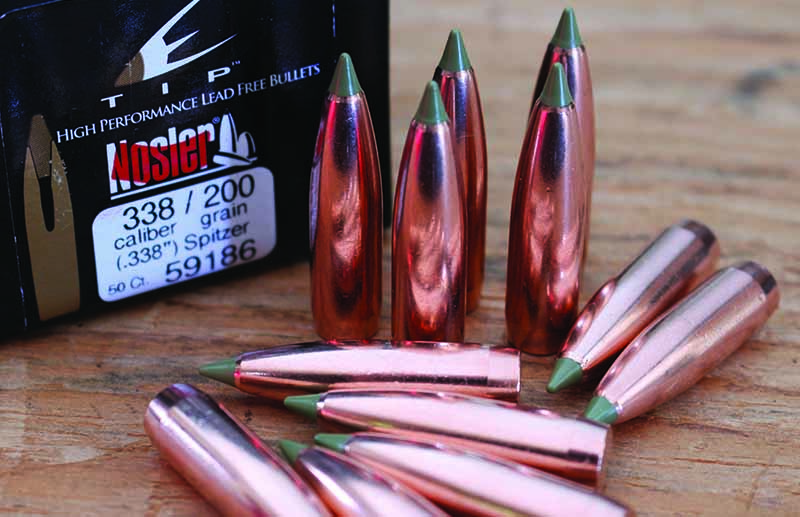
The internal ballistics are a different story altogether and, depending on the particular application, can be eye-opening.
For example, the 6.5mm cartridges, which all shine with a good, 140-grain, lead-core bullet, generally struggle with a monometal bullet heavier than 130 grains, with many factory loads using monometals between 120 and 127 grains. The heavier copper bullets are just too long for stable flight, at least in the 6.5mm bore with a common twist rate. Other bore diameters are seemingly unaffected. Most of the popular .30-calibers can use 180- and 200-grain monometals, and the .375s, .416s, and .458s can also use the 300-, 400-, and 500-grain monometals, respectively.
Is it a deal breaker if your cartridge/rifle/barrel won’t stabilize the bullets you wish to use? Well, in spite of the increase in terminal performance when compared to a standard cup-and-core bullet of equal weight, the ballistic coefficient of a 120-grain, 6.5mm bullet is simply not that of a 140-grain, 6.5mm bullet; and, in today’s world, that might pose an issue.
Furthermore, although the retained weight of the monometals is often excellent (90 percent and above), there are times where the reduction in weight isn’t a great idea. Brown bears, moose, and elk often require a certain weight of bullet to ensure a quick kill, and dropping to a lighter bullet at a higher velocity isn’t always the best idea.
All Hands On Deck
Barnes, while nearly synonymous with monometal expanding bullets, is not the only source. Many of the major manufacturers have at least one monometal offering, because the use of lead bullets has been legally prohibited in California. Besides the wide product line from Barnes, Federal’s Trophy Copper, Hornady’s GMX (Gilding Metal eXpanding), Norma’s EcoStrike, Nosler’s E-Tip, Ballistic Tip Varmint Lead Free and Solid, Lapua’s Naturalis, the Woodleigh Hydrostatically Stabilized Solid and Winchester’s Deer Season XP Copper comprise the major manufacturers. Then, there are boutique offerings such as the Lehigh bullets, the Raptor from Cutting Edge Bullets, North Fork’s Cup Solid, and, my particular favorite of the boutique companies: South Africa’s Peregrine Bullets, makers of the PlainsMaster and BushMaster bullets.
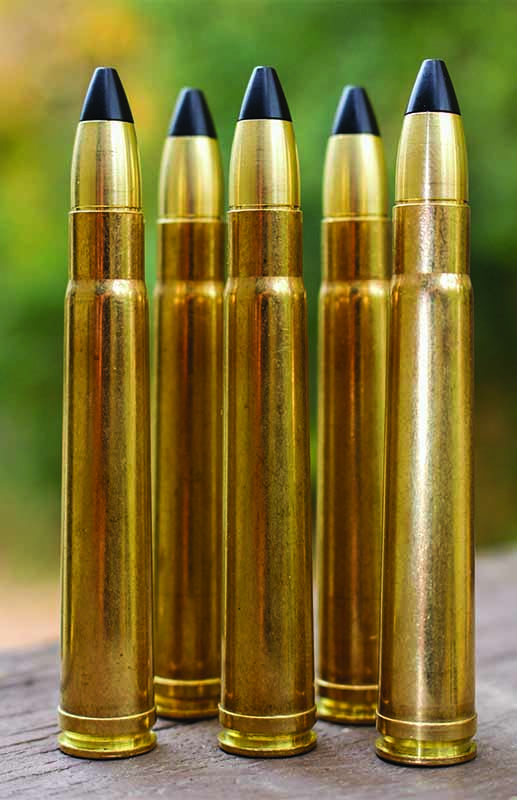
While most monometal bullets are designed to mimic the performance of their cup-and-core counterparts, some offer a unique means of getting the job done.
For example, the North Fork Cup Solid, which is once again being produced in Sweden, is designed not only for the deep, bone-crushing penetration of a solid, it’ll also give the slightest amount of expansion at the nose to increase tissue damage—and it does it well. The Cutting Edge Raptor is specifically designed to have the ogive section break apart, separating into little blades that cause a significant amount of tissue damage for the first portion of the wound channel, spinning in a star pattern, while the caliber-dimension base penetrates deeply, like a solid.
The 235-grain, .375-inch-caliber Raptor ranks among my favorite African plains game bullets. The Peregrine BushMaster bullets use a flat brass plunger over a hollow-point, and because the air in the cavity can’t be easily compressed, the sidewalls of the bullet are blown open for excellent expansion. Retained weight is well into the mid-90-percent range, and I’ve recovered a number of them against the offside skin of Cape buffalo bulls.
Woodleigh’s Hydrostatically Stabilized Solid is perhaps the most unique and revolutionary design. It uses a depression in the nose of the bullet to create a low-pressure cavitation bubble that clears the way for the bullet to penetrate. Aside from straight-line penetration, that cavitation bubble results in a cylinder of blood-shot tissue 8 to 12 inches in diameter, destroying the blood-rich vital tissue and causing a quick, humane death. They are accurate, and when they’re of suitable caliber and weight, they’re capable of taking any game animal on Earth.
Is There a Change In The Wind?
Are monometal bullets going to eventually replace the copper jacket/lead core formula? I don’t think you’ll see that happening anytime soon, although their popularity is most definitely gaining ground each year. Many African professional hunters rely on monometal soft-points and solids for their day-to-day work among the most dangerous animals on Earth and highly recommend them to their clients.
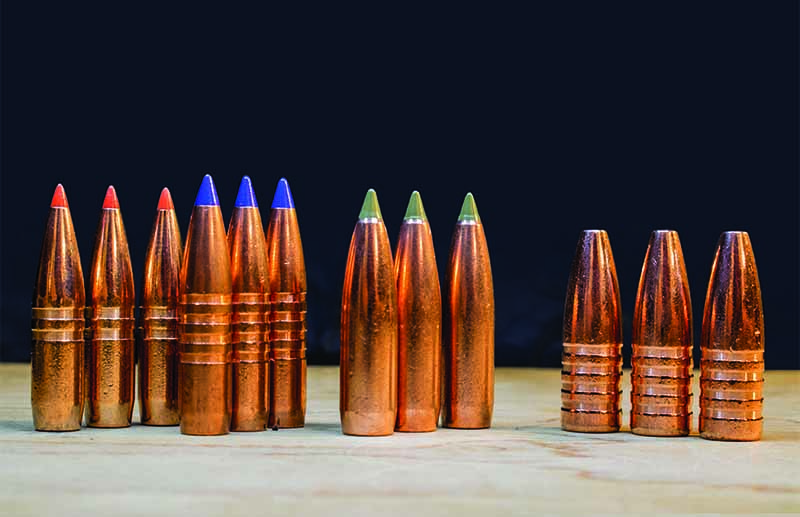
The monometals have also made their way into the target community, with both Cutting Edge Bullets and Peregrine Bullets making their presence known, especially among the extreme-long-range shooters. The Barnes XPB and Cutting Edge Handgun Raptor bring the lead-free bullets to the handgun market, and the Hornady NTX and Nosler BTLF (Ballistic Tip Lead Free) give varmint and predator hunters a lead-free option as well.
In contrast, the reduced cost of lead-core projectiles in comparison to lead-free projectiles plays a pivotal role in the choice of material, and I don’t feel the shooting public is willing to abandon such great designs as the Sierra MatchKing, Swift A-Frame, or Nosler Partition, not to mention the bulk ammunition available in .45 ACP, 9mm Luger, 5.56 NATO, and others.
Could I satisfy all my hunting needs with lead-free ammo? For big game, yes, but for small game, there’s a void, especially in the rimfire cartridges. And, although there are varmint/predator choices available, they’re lighter than I like to use for my rifles, especially on a big coyote at longer ranges.
California has mandated the use of lead-free ammunition, stating environmental reasons (such as the endangered carrion birds eating on gut piles and being poisoned by lead fragments). I can’t attest to the validity of this, nor am I willing to write off the possibility that prohibiting lead projectiles is just another means of exercising control over our firearms, but the law is in place, and hunters have to work around it.
Monometal bullets are assuredly here to stay, because the technology has developed to the point at which they’ve become both reliably accurate and lethal. Some are more finicky than others—showing sensitivity to seating depth and bullet jump—but I won’t say that there’s one design or another a hunter should avoid.
Bet on seeing more lead-free ammunition in the near future.
Editor's Note: This article originally appeared in the November 2020 issue of Gun Digest the Magazine.

Next Step: Get your FREE Printable Target Pack
Enhance your shooting precision with our 62 MOA Targets, perfect for rifles and handguns. Crafted in collaboration with Storm Tactical for accuracy and versatility.
Subscribe to the Gun Digest email newsletter and get your downloadable target pack sent straight to your inbox. Stay updated with the latest firearms info in the industry.

![Best Concealed Carry Guns In 2025 [Field Tested] Wilson Combat EDC X9S 1](https://gundigest.com/wp-content/uploads/Wilson-Combat-EDC-X9S-1-324x160.jpg)


![Best 9mm Carbine: Affordable PCCs [Tested] Ruger Carbine Shooting](https://gundigest.com/wp-content/uploads/Ruger-Carbine-Shooting-100x70.jpg)
![Best AR-15: Top Options Available Today [Field Tested] Harrington and Richardson PSA XM177E2 feature](https://gundigest.com/wp-content/uploads/Harrington-and-Richardson-PSA-XM177E2-feature-100x70.jpg)

How well will they work at long range, say 800 to 1000 yds in a 7 mag for whitetail? I live in the southeast, so we do a lot of beanfields and cut cornfields.